Balbharti Maharashtra State Board Class 12 Economics Solutions Chapter 4 Supply Analysis Textbook Exercise Questions and Answers.
Std 12 Economics Chapter 4 Question Answer Supply Analysis Maharashtra Board
Class 12 Economics Chapter 4 Supply Analysis Question Answer Maharashtra Board
Economics Class 12 Chapter 4 Question Answer Maharashtra Board
1. Complete the following statements:
Question 1.
Price elasticity of demand on a linear demand curve at the X-axis is ……………
a) zero
b) one
c) infinity
d) less than one
Answer:
a) zero
![]()
Question 2.
Price elasticity of demand on a linear demand curve at the Y-axis is equal to
a) zero
b) one
c) infinity
d) greater than one
Answer:
c) infinity
Question 3.
Demand curve is parallel to X axis, in case of …………..
a) perfectly elastic demand
b) perfectly inelastic demand
c) relatively elastic demand
d) relatively inelastic demand
Answer:
a) perfectly elastic demand
Question 4.
When percentage change in quantity demanded is more than the percentage change in price, the demand curve is ………………..
a) flatter
b) steeper
c) rectangular
d) horizontal
Answer:
a) flatter
Question 5.
Ed = 0 in case of ………………
a) luxuries
b) normal goods
c) necessities
d) comforts
Answer:
c) necessities
2. Give et onomic terms:
Question 1.
Degree of responsiveness of quantity demanded o change in income only.
Answer:
Income elasticity
Question 2.
Degree of responsiveness of a change in quantity demanded of one commodity due to change in the price of another commodity.
Answer:
Cross elasticity
![]()
Question 3.
Degree of responsiveness of a change of quantity demanded of a good to a change in its price.
Answer:
Elasticity of demand
Question 4.
Elasticity resulting from infinite change in quantity demanded.
Answer:
Perfectly elastic demand
Question 5.
Elasticity resulting from a proportionate change in quantity demanded due to a proportionate change in price.
Answer:
Price elasticity
3. Complete the correlation:
1) Perfectly elastic demand: Ed = ∞ :: ……………. : Ed = 0
2) Rectangular hyperbola : ………………. : Steeper demand curve : Relatively inelastic demand.
3) Straight line demand curve : Linear demand curve:: …………….. non linear demand curve.
4) Pen and ink : …………….. :: Tea or Coffee: Substitutes.
5) Ratio method : Ed = \(\frac{\% \Delta \mathbf{Q}}{\% \Delta \mathrm{P}}\) :: …………… : Ed = \(\frac{\text { Lower segment }}{\text { Upper segment }}\)
Answer:
- Perfectly inelastic demand
- Unitary elastic demand
- Unitary elastic (convex to origin)
- Complementary goods
- Point or Geometric method
4. Assertion and Reasoning type questions:
Question 1.
Assertion (A) : Elasticity of demand explains that one variable is influenced by another variable.
Reasoning (R) : The concept of elasticity of demand indicates the effect of price and changes in other factors on demand.
Options: 1) (A) is True, but (R) is False
2) (A) is False, but (R) is True
3) Both (A) and (R) are True and (R) is the correct explanation of (A)
4) Both (A) and (R) are True and (R) is not the correct explanation of (A)
Answer:
3) Both (A) and (R) are True and (R) is the correct explanation of (A)
![]()
Question 2.
Assertion (A) : A change in quantity demanded of one commodity due to a change in the price of other commodity is cross elasticity.
Reasoning (R) : Changes in consumers income leads to a change in the quantity demanded.
Options:
1) (A) is True, but (R) is False
2) (A) is False, but (R) is True
3) Both (A) and (R) are True and (R) is the correct explanation of (A)
4) Both (A) and (R) are True and (R) is not the correct explanation of (A)
Answer:
4) Both (A) and (R) are True and (R) is not the correct explanation of (A)
Question 3.
Assertion (A) : Degree of price elasticity is less than one in case of relatively inelastic demand.
Reasoning (R): Change in demand is less then the change in price.
Options: 1) (A) is True, but (R) is False
2) (A) is False, but (R) is True
3) Both (A) and (R) are True and (R) is the correct explanation of (A)
4) Both (A) and (R) are True and (R) is not the correct explanation of (A)
Answer:
3) Both (A) and (R) are True and (R) is the correct explanation of (A)
5. Distinguish between:
Question 1.
Relatively elastic demand and Relatively inelastic demand.
Answer:
Relatively Elastic Demand
- When percentage change in quantity demanded is greater than the percentage change in price then demand is said to be Relatively Elastic demand.
- The numerical co-efficient is greater than one (e > 1).
- Demand curve slopes flatter.
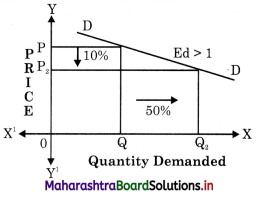
- Example : luxury goods like LCD, TV, Car etc.
Relatively inelastic demand.
- When percentage change in quantity demanded is less than percentage change in price then demand is said to be Relatively Inelastic demand.
- The numerical co-efficient is less than one (e < 1).
- Demand curve slopes steeper.
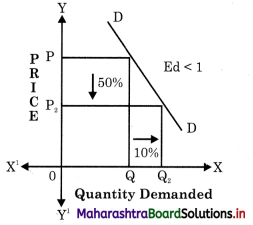
- Example : foodgrains.
![]()
Question 2.
Perfectly elastic demand and Perfectly inelastic demand.
Answer:
Perfectly elastic demand :
- When a small change in price brings an infinite change in quantity demanded, then demand is said to be Perfectly Elastic demand.
- The numerical value of Perfectly Elastic demand is infinite i.e. e = ∞
- The demand curve is horizontal straight line parallel to X-axis.
- Such a demand is a myth or theoretical.
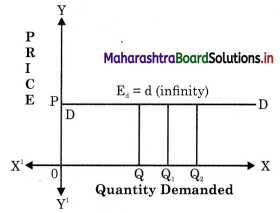
Perfectly inelastic demand.
- When a change in price does not bring any change in quantity demanded, then demand
is said to be Perfectly Inelastic demand. - The numerical value of Perfectly Inelastic demand is zero i.e. e = 0.
- The demand curve is a vertical straight line parallel to Y—axis.
- Such demand is found in case of life saving drugs, salt, etc.

6. Answer the following questions:
Question 1.
Explain the factors influencing elasticity of demand.
Answer:
The concept of Price Elasticity was developed i by great neo-classical economist Dr. Alfred \ Marshall in the year 1890.
According to Dr. Alfred Marshall, “The elasticity or responsiveness of demand in a market is great or small, according to the amount demanded which increases much or little for a given fall in price, and diminishes much or little for a given rise in price. ”
Elasticity of demand in fact refers to the £ degree of responsiveness of the quantity demanded of a commodity to change in the variable on which demand depends.
Question 2.
Explain the total outlay method of measuring elasticity of demand?
Answer:
Total Outlay Method : This method was introduced by Dr. Alfred Marshall. The limitation of this method is that in this method unlike ratio method, the exact numerical value of the elasticity of demand cannot be determined. According, to this method, the elasticity of demand is measured on the basis of expenditure incurred by consumer when the price of a commodity changes.
Total outlay or total expenditure can be calculated by multiplying the price with the quantity demanded (Price x Quantity demand = Total Expenditure). Depending upon the kind of change in total outlay, whether it increases, or decreases, or remain constant with the change in price we will be able to decide the type of elasticity. This can be explained with the following example:-

- If the total outlay remains the same with a rise or fall in price then the demand is said to be unitary (e = 1) elastic.
- If the total outlay decreases with a rise in price and increases with a fall in price, the elasticity of demand is greater than one or Relatively Elastic e > 1.
- If the total outlay increases with a rise in price and decreases with a fall in price, then elasticity is less than one or relatively inelastic, e < 1.
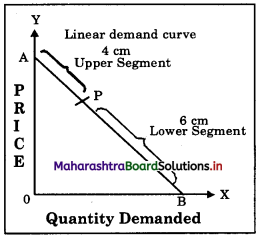
![]()
Question 3.
Explain importance of elasticity of demand.
Answer:
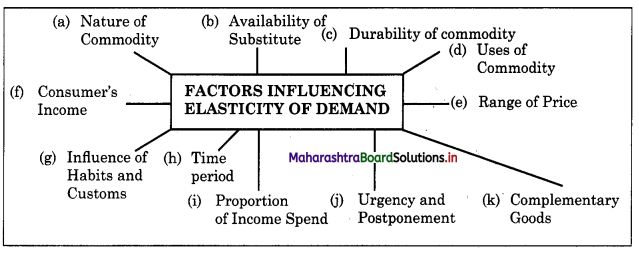
- Nature of Commodity : By nature, commodities are classified as necessaries, comforts and luxuries. Normally demand for j necessaries like food grains are relatively inelastic and for comforts and luxuries like diamond, perfumes, etc is relatively elastic.
- Availability of Substitutes : The larger the number of substitutes available for a commodity, the greater would be the elasticity. Demand for products like soap, soft drinks, detergents, tooth paste, etc. have many substitute so demand is elastic, ‘j However, salt, garlic, onions have no substitute so demand is inelastic.
- Durability of the Commodity : The demand for durable goods like T.V., car, fridge, etc is relatively inelastic in the short run and elastic in the long run. Whereas the demand for perishable goods is relatively inelastic.
- Uses of Commodity : Single use commodities have less elastic demand and multi-use goods like coal, electricity, sugar, etc. have relatively elastic demand.
- Range of Price : The demand for commodities which are highly priced and will have a inelastic demand like AC, car, etc. Even very low priced goods have inelastic demand.
- Consumer’s Income : Generally if income is very high, the demand for over allcommodities tends to be relatively inelastic. The demand pattern of the rich people is rarely affected even when there is significant price change.
- Influence of Habits and Customs : When a person is habituated to consume a certain commodity, the demand will be inelastic for that commodity. E.g. demand for cigarettes to a chain smoker is inelastic.
- Time Period : The demand for goods is less elastic in the short period and more elastic in the long period. This is because (1) in the long period consumer are better informed about their price (2) habits of consumer’s change in the long run (3) durable goods get worn out in the long period.
- Proportion of Income Spend : If consumer spends a very small proportion of his income on a commodity, the demand for it will be relatively inelastic & vice-versa. For e.g. demand for salt, newspaper, pins are inelastic.
- Urgency and Postponement : If the demand for a commodity is urgent then demand for it will be inelastic. E.g. demand for medicine for a patient. Whereas, if the demand for a commodity can be postponed it will have elastic demand.
- Complementary Goods : Complementary goods are those goods which are demanded jointly such as car and petrol, mobile and sim cards, etc. Demand for petrol will be inelastic as car cannot run without petrol.
7. Observe the following figure and answer the questions:
Question 1.
Identify and define the degrees of elasticity of demand from the following demand curves.

Answer:
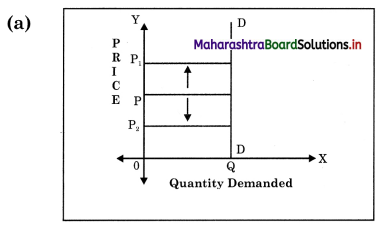
Concept: Perfectly Inelastic demand (Ed = 0) Explanation : When change in price has no effect on the quantity demanded of that commodity, then it is called as perfectly inelastic demand. Demand curve ‘DD’ is a vertical straight line parallel to ‘Y’ – axis.
![]()
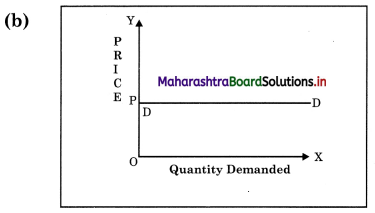
Concept: Perfectly Elastic demand (Ed = ∞) (infinity)
Explanation: When a change in price leads to infinite change in quantity demanded of a commodity then it is called as perfectly) (d) elastic demand.
Demand curve is horizontal straight line ( parallel to ‘X’ – axis.

Concept: Ed = 1 Unitary elastic demand Explanation : When proportionate or percentage change in quantity demanded is exactly equal to proportionate or percentage change in price, then it is called as Unitary Elastic demand. Demand curve is called as rectangular hyperbola.
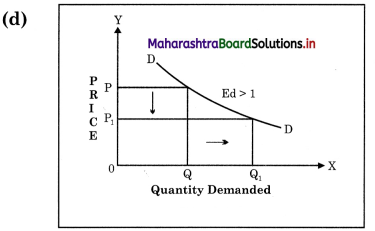
Concept: Relatively Elastic Demand (Ed > 1)
Explanation : When proportionate or percentage change in quantity demanded is more than proportionate change it its price, then it is called as Relatively Elastic Demand. Demand curve is called as flatter curve.
Question 2.
In the following diagram AE is the linear demand curve of a commodity. On the basis of the given diagram state whether the following statements are True or False. Give reasons to your answer.
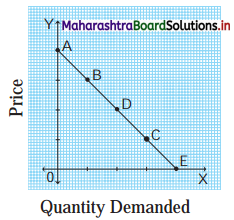
1) Demand at point ‘C’ is relatively elastic demand.
2) Demand at point ‘B’ is unitaiy elastic demand.
3) Demand at point ‘D’ is perfectly inelastic demand.
4) Demand at point ‘A’ is perfectly elastic demand.
Answer:
- Demand at point ‘C’ is relatively elastic demand.
- False, it is relatively inelastic demand.
- False, it is relatively elastic demand.
- False, it is unitary elastic demand.
- True, it is perfectly elastic Ed = ∞
12th Std Economics Questions And Answers:
- Introduction to Micro and Macro Economics Class 12 Economics Questions And Answers
- Utility Analysis Class 12 Economics Questions And Answers
- Demand Analysis Class 12 Economics Questions And Answers
- Elasticity of Demand Class 12 Economics Questions And Answers
- Supply Analysis Class 12 Economics Questions And Answers
- Forms of Market Class 12 Economics Questions And Answers
- Index Numbers Class 12 Economics Questions And Answers
- National Income Class 12 Economics Questions And Answers
- Public Finance in India Class 12 Economics Questions And Answers
- Money Market and Capital Market in India Class 12 Economics Questions And Answers
- Foreign Trade of India Class 12 Economics Questions And Answers